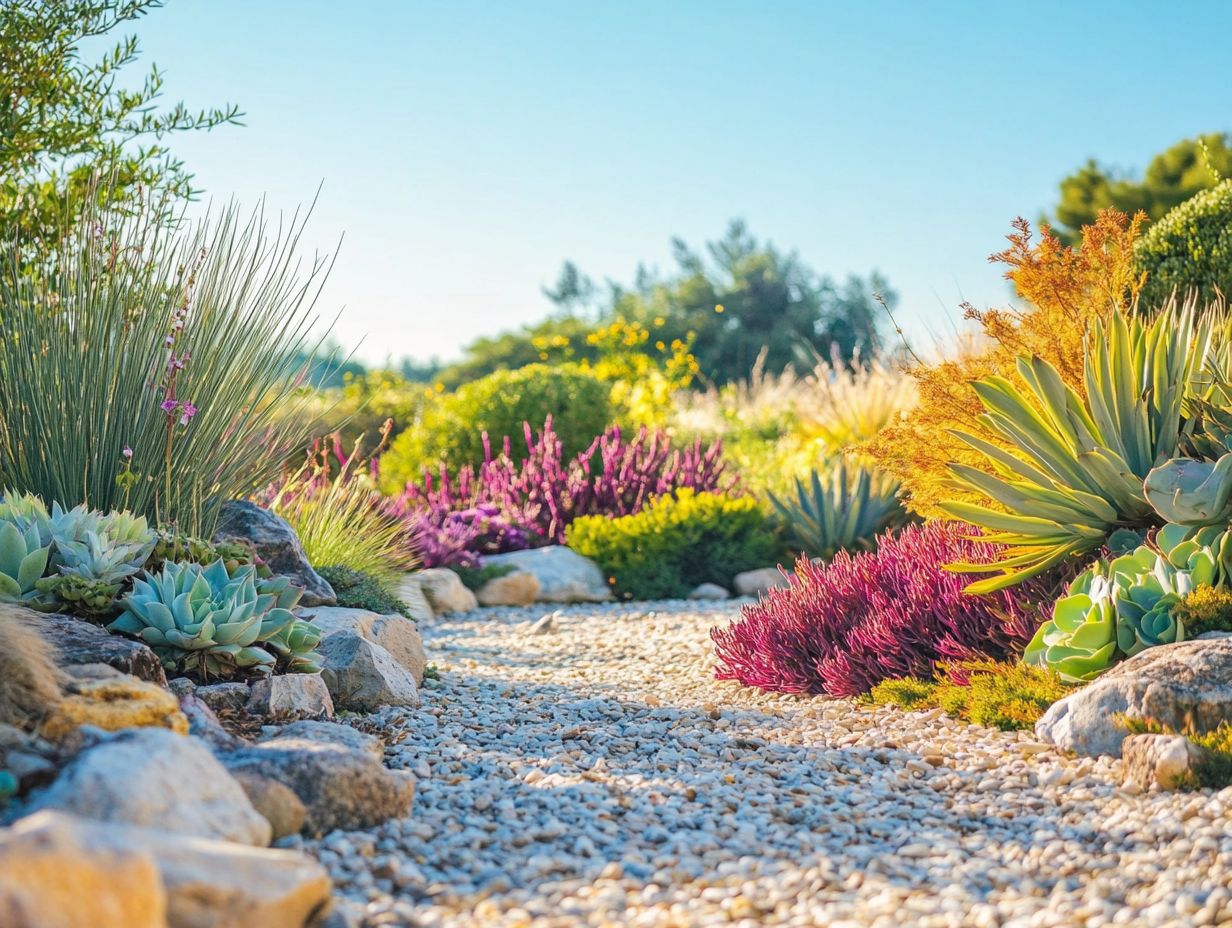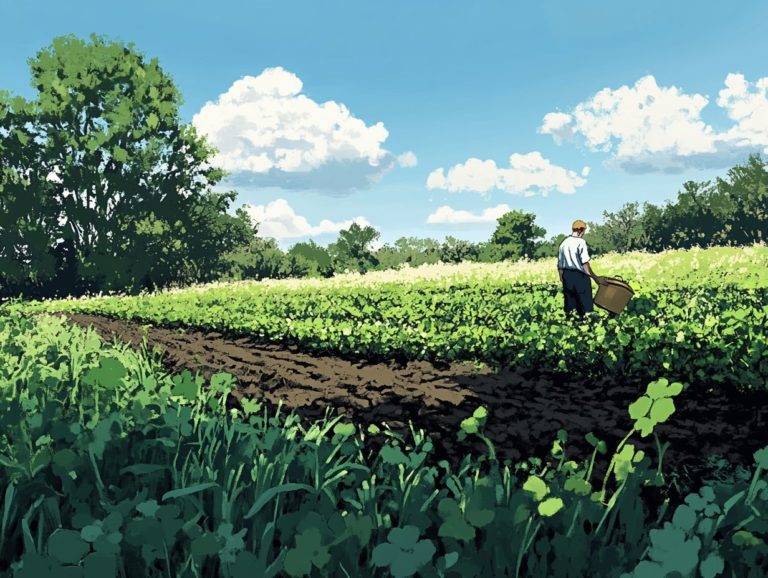Creating a Drought-Tolerant Landscape
As climate change increasingly affects our environment, grasping the concept of drought-tolerant landscapes becomes essential for sustainable living. This article delves into what these landscapes are and the myriad benefits they offer, along with practical design strategies and guidance on selecting plants that require less water. You ll uncover effective water-saving techniques and maintenance tips to ensure your garden flourishes throughout the year.
By the conclusion, you’ll appreciate how embracing a drought-tolerant landscape not only conserves water but also presents significant environmental and financial advantages.
Contents
- Key Takeaways:
- Understanding Drought-Tolerant Landscapes
- Designing a Drought-Tolerant Landscape
- Implementing Water-Saving Techniques
- Maintaining a Drought-Tolerant Landscape
- Benefits of a Drought-Tolerant Landscape
- Frequently Asked Questions
- What is a drought-tolerant landscape?
- Why should I consider creating a drought-tolerant landscape?
- What are some key elements of a drought-tolerant landscape?
- Do I have to sacrifice aesthetic appeal for a drought-tolerant landscape?
- Is it more difficult to maintain a drought-tolerant landscape?
- How do I get started with creating a drought-tolerant landscape?
Key Takeaways:

- Create a drought-tolerant landscape to save water and money. Incorporate plants that require less water and water-saving techniques into your design.
- Consider factors like climate and soil when designing a drought-tolerant landscape. Choose plants that can thrive in dry conditions and use efficient watering methods.
- Maintain your drought-tolerant landscape year-round. Regular upkeep and addressing drought-related challenges can ensure the success of your landscape.
Understanding Drought-Tolerant Landscapes
Understanding drought-tolerant landscapes is crucial, especially in regions like Texas, where unpredictable weather and extended dry spells pose challenges to traditional gardening. By transforming your landscape for drought, you can implement landscaping methods that require less water, enhance the variety of life in your garden, and optimize water conservation, creating sustainable outdoor spaces.
Emphasizing native plants and varieties that need less water allows you to reduce your dependence on irrigation while fostering a vibrant ecosystem that can adapt to the demands of time and climate change.
Definition and Benefits
Drought-tolerant landscapes, often crafted through effective landscaping methods, embrace design principles that prioritize water conservation and the integration of native plants. For those looking to enhance their gardens, creating a wildlife-friendly drought garden can help in creating a sustainable and eco-friendly haven.
You can significantly reduce the need for extensive irrigation systems by adopting this approach, conserving precious water resources while also lowering your monthly utility bills. Selecting plants that require less water and using strategic mulching can dramatically lessen the maintenance time compared to traditional lawns.
These thoughtfully designed spaces enhance local wildlife habitats, contributing positively to the ecosystem. Embracing these landscaping practices not only elevates your home s aesthetic appeal but also fulfills essential environmental responsibilities, fostering resilience in the face of climate challenges.
Designing a Drought-Tolerant Landscape
Creating a drought-tolerant landscape is an exciting opportunity to transform your outdoor space! It requires careful attention to several key factors. Be sure to consider plant selection, soil conditions, and the unique nuances of your local climate, especially in regions like Texas, where water resources may be scarce.
Factors to Consider
When designing a drought-tolerant landscape, it’s essential to evaluate factors like local climate, soil quality, humidity levels, and drainage. These elements play a vital role in ensuring your plant selections thrive, and understanding how to create a wildlife-friendly drought garden can enhance your efforts further.
By assessing your region s climate, you can choose the most resilient plants for your environment. Evaluating soil quality is equally important, as it provides the nutrients your plants need. You can enhance soil quality using amendments like compost, which improve both structure and water retention. Effective water management techniques, such as drip irrigation and mulching, will not only conserve water but also help regulate soil temperature.
Grouping plants with similar watering needs can create a harmonious ecosystem. For instance, pairing succulents with native grasses allows them to thrive together with minimal maintenance. These strategies work together to cultivate a sustainable and visually stunning landscape.
Start your journey to a beautiful, water-saving garden today every small step counts!
Choosing Drought-Resistant Plants

Selecting the right drought-resistant plants is essential for crafting a flourishing landscape that conserves water and endures the tough Texas weather. Options like ornamental grasses, cacti, and native shrubs are not just practical; they’re excellent choices that can transform your garden.
Incorporating these plants minimizes water usage while elevating the overall aesthetics of your space. For example, ornamental grasses introduce delightful texture and movement. Cacti offer unique shapes and vibrant colors, turning your garden into a visual masterpiece.
When integrating these plants into your garden beds, group them by their similar water and light requirements. This approach simplifies maintenance and fosters healthier growth. The diversity of these drought-resistant options also promotes biodiversity by attracting various pollinators and beneficial insects.
By cultivating a mix of these resilient plants, you can significantly enhance the ecological stability of your environment. This creates a landscape that not only looks good but also contributes positively to nature.
Implementing Water-Saving Techniques
Implementing water-saving techniques is key to creating a drought-tolerant garden, particularly in regions like Texas, where water scarcity can impact both your gardens and your budget.
Irrigation Methods
Choosing the right irrigation methods is crucial for conserving water in your drought-tolerant landscape. Options like drip irrigation, a watering system that delivers water directly to the roots of plants, provide targeted watering, minimizing waste while ensuring your plants thrive.
You might also want to explore alternatives such as soaker hoses or automated sprinkler systems. These options are crafted to deliver water more efficiently. Soaker hoses gradually release moisture along their length and are especially beneficial for garden beds.
Smart sprinklers equipped with weather sensors can adjust your watering schedules based on recent rainfall, making them a savvy choice. Adopting these water-efficient systems can significantly reduce your overall water consumption and lead to a noticeable drop in your utility bills.
Implementing mulch around your plants retains soil moisture and enhances the effectiveness of these irrigation techniques. Regular maintenance and timely adjustments to your irrigation system are crucial for achieving optimal results.
Using Mulch and Other Strategies
Using mulch is a game-changer for keeping your soil moist! It can significantly enhance soil moisture retention, reduce evaporation, and improve drainage, making it an essential strategy for effective water conservation.
Various types of mulch spanning organic options like shredded bark and grass clippings to inorganic selections such as gravel play a crucial role in suppressing weed growth and regulating soil temperature. When applied correctly, mulch forms a protective barrier that fosters healthy microbial activity.
For optimal results, aim for a depth of 2 to 4 inches. This allows water to penetrate while preventing tools and foot traffic from compacting the soil.
By crafting a well-mulched environment, you can boost plant vitality and cultivate a thriving ecosystem beneath the surface.
Maintaining a Drought-Tolerant Landscape
Maintaining a drought-tolerant landscape goes beyond the initial design. You must continually pay attention to critical factors like soil quality, seasonal fluctuations, and integrating drought plants into landscapes to truly flourish in Texas’s challenging climate.
Start your drought-resistant garden today and help save water!
Year-Round Maintenance Tips

Year-round maintenance of a drought-tolerant landscape requires your attention to soil quality and plant health.
Adaptations to seasonal shifts are essential for long-term sustainability.
To manage this type of landscape effectively, developing a detailed list of tasks tailored to each season is key. For instance, during spring, applying necessary soil amendments can enhance nutrient levels. Pruning away dead or overgrown branches encourages healthier growth.
As temperatures rise in the hotter months, monitoring watering requirements becomes crucial. Different plants have varying needs based on temperature fluctuations.
When fall arrives, evaluating the overall health of your landscape and preparing your plants for winter is vital. This preparation ensures they can withstand the cooler months ahead.
By aligning your maintenance practices with the unique requirements of each season, you can cultivate a thriving environment for drought-tolerant species.
Dealing with Drought-Related Challenges
Dealing with drought-related challenges in your landscape might seem challenging, but understanding potential plant health issues and adapting your watering practices can enhance resilience against climate change.
Managing pests and diseases is crucial when your plants are stressed due to inconsistent water supply. Even drought-tolerant species can be vulnerable to infestations during extended dry spells, making regular monitoring essential.
By conducting routine inspections, you can catch issues early and implement organic pest control methods or introduce beneficial insects as natural remedies.
Employing strategies like mulching and choosing companion plants can help relieve some stress on drought-sensitive species while improving soil moisture retention. By taking a proactive approach and adapting to your landscape’s evolving needs, you can navigate the persistent challenges posed by a changing environment.
Benefits of a Drought-Tolerant Landscape
The advantages of a drought-tolerant landscape extend beyond aesthetics. It positively influences property value, promotes biodiversity, and significantly impacts environmental conservation through enhanced water conservation efforts.
Choosing this sustainable approach beautifies your space and contributes meaningfully to the planet.
Environmental and Financial Advantages
Adopting drought-tolerant landscaping practices offers remarkable environmental benefits and significant financial perks as a homeowner. This is especially true when it comes to lowering utility bills and maintenance costs.
By choosing native plants that thrive with minimal water, you could potentially save an impressive amount estimates suggest reducing your water usage by up to 50%. This eases the burden on local water supplies and leads to lower monthly utility bills, freeing up your budget for other important expenses.
The long-term ecological benefits are substantial; these landscapes enhance local biodiversity, providing vital habitats for various species and promoting healthier soil. Communities that embrace these sustainable practices often see an increase in property values, contributing to a more vibrant and resilient environment for generations to come.
Frequently Asked Questions
What is a drought-tolerant landscape?

A drought-tolerant landscape consists of plants and design elements that can withstand extended periods of dry weather without excessive watering, as outlined in our guide on how to create a drought-resistant garden.
Why should I consider creating a drought-tolerant landscape?
Creating a drought-tolerant landscape can significantly reduce your water usage and save you money on your water bills. For effective strategies, check out how to design a drought-tolerant garden. It also helps conserve water during times of drought and is more environmentally friendly.
What are some key elements of a drought-tolerant landscape?
Key elements include using native plants that thrive in your local climate. Incorporating mulch helps retain moisture, and efficient methods like drip irrigation deliver water directly to plant roots.
Do I have to sacrifice aesthetic appeal for a drought-tolerant landscape?
No way! You can have a stunning drought-tolerant landscape filled with beautiful, colorful plants.
With the right design, it can be just as visually appealing as traditional landscapes.
Is it more difficult to maintain a drought-tolerant landscape?
No, maintaining a drought-tolerant landscape can be simpler than traditional gardens. Once established, these plants need less watering and care compared to non-drought-tolerant varieties.
How do I get started with creating a drought-tolerant landscape?
Start by researching plants suitable for your region’s climate. Then, design your landscape with features like mulch and efficient watering systems by following a guide on establishing a drought-tolerant garden.
Consider consulting a professional landscaper for expert advice and guidance.






